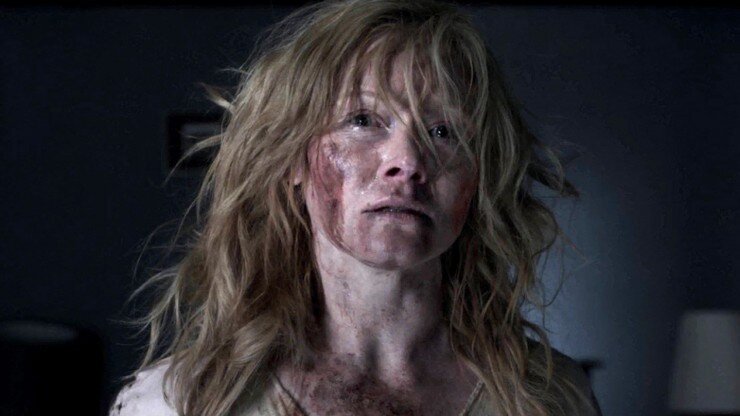The Monster That Is Mental Illness
By Emily Black
The monsters of cinema tend to manifest themselves in ghouls, zombies and ghosts – that which the protagonist must slay or succumb to. But, what if we were introduced to a creature that wasn’t so much made of supernatural energy, rotting flesh, or the spirit of someone now dead, but instead, an uncharted form that embodies the dark side of the psyche? Jennifer Kent’s The Babadook (2014) presents us with a female protagonist, Amelia Vanek (Essie Davis) who is up against this different kind of monster. Mister Babadook, the character from her son’s story book, is not so much a malevolent physical being, but a menace of the mind.
Amelia begins exactly as a reasonable, female protagonist should, dressed in pink, petite, blonde, and unargumentative. She is devoted to her son, overtly caring to her neighbours, and works hard at an old person’s home. In every sense Amelia is a caregiver. The film begs the question, what happens when women care for those around them, neglecting their own mental health in the process? In many ways, this neglect of self is exactly what motherhood asks of women.
After losing her husband in a car accident and then enduring the trauma of childbirth, Amelia should be the one receiving care, not giving it. The film takes place almost seven years after the incident occurred, and perhaps people just got fed up with caring?
Amelia now navigates motherhood alone, in the vast grey house where she lives with her son – an allegory for the liminal space of grief. The black walls and gothic furniture swallow them up as their emotions do; the house serves as a reminder that though funerals pass, you continue to live amidst their aftermath.
Kent uses setting to convey what is shut away during grief, she represents this physically in the door to the basement, which remains locked. Trauma becomes a thing that sits below the surface and can be locked below life – yet this doesn’t mean it’s not there. Amelia’s son, Samuel, tries to play amongst his father’s items in the basement, and as a mother it is her duty to address these relics; but as a wife, Amelia has every right to deal with these items in her own time. Amelia is caught between two identities – that of the wife, and that of the mother.
Not only do we see her play out the strength of an unflinching mother, for the benefit of Samuel, but we’re also allowed an insight into her mind. Ultimately, Amelia is not a reliable narrator, as we’re aligned with her mental process through Kent’s portrayals of sleep. Some nights pass in the blink of an eye, and others are lived out in hazy waking nightmares – Amelia’s insomnia is palpable. We see Amelia find glass in the soup they eat for dinner, we see Samuel stood on top of a swing set, we see him covered in blood on the sofa. But did any of this really happen, or are we just made to live out a mother’s worst nightmare?
The book, Mister Babadook, manifests itself as a physical copy of Amelia’s anxiety. She catastrophizes about the future in the wake of grief, and therefore sees herself killing the dog, strangling her son, and killing herself. With limited sleep, and a rapid descent into a state of psychosis, the story book arrives in the house in the same manner as Amelia’s deterioration – dark and uninvited. The illustrations draw on German Expressionism, giving her mental state a stylistic representation that then helps us visualise her trauma. The book embodies Amelia’s fear that the worst will happen, and the only person at fault is herself.
Amelia locks herself in the house with Samuel when the Babadook appears in the form of a tall figure in a coat and hat. This marks the beginning of a state of insanity. Amelia turns from the role of female caregiver, to a woman possessed by a monster, as she now wants to hurt her son. In many ways, she spends the first half of the film fighting the monster, and the scenes that follow, inhabiting it.
Similar portrayals of the personification of grief and trauma have been explored in recent literature and film, when it comes to the trope of horror and the gothic. Max Porter’s novella Grief Is The Thing With Feathers (2015) presents grief in the form of a black, feathered crow – a silhouette not dissimilar to the Babadook and his pointed fingers – who helps two young boys navigate the loss of their mother, alongside their grieving father. Similarly, His House (2020) manifests horror in the trauma of fleeing from civil war. Once again, the monster crawls up from beneath the floor, inhabiting the walls and the very fabric of the house, of life, of memory. Mental illness and grief are creatures that lurk in the shadows, showing themselves only when they’ve scared you first. The only way you can negotiate with them, is by confronting them.
In the climax of the film, the Babadook rises above Amelia, winged and shadowed, after she’s spent most of her time running from the monster. Enduring the full force of the beast, Amelia is knocked off her feet, before she turns to scream the words, “You’re trespassing.” In order to confront the monster, Amelia has to become it. She is inhabited by the beast, screaming and thrashing, a danger to her son; the very opposite of everything she was at the beginning of the film. Still dressed in pink, but now smeared with blood and dirt, she must destroy the very essence of this caregiver-femininity, in order to fend for herself. She acknowledges the monster after an episode of possession.
Jennifer Kent’s debut is a reminder that your child doesn’t stop needing you, regardless of the mental tumult you may be going through. The mother’s role doesn’t cease to exist when the very thing that broke her was the delivery of her son. Mothers are still expected to wear pastel cardigans and care for their children – even when a beast lives below the floorboards.
The penultimate scene, in which Amelia feeds Mister Babadook a bowl of worms, depicts the very nature of the monster of mental illness. She must nurture the beast in the shadows in order to bargain with it. Very few horror films end with a protagonist living alongside their monster – and even fewer end with a solo female matriarch still alive. Whilst creatures that emerge from the dark usually give children a reason to be scared, The Babadook teaches us that a story book monster can become a tool for navigating grief and mental illness. To an extent, we all have a monster at the back of our mind that needs feeding, and it won’t get any happier if we spend our lives ignoring it.
Emily Black’s work has appeared on The Litro Lab Podcast, in Enigma Journal, Ginosko Journal, The Tilt, Ellipses Zine and Disgraceful Magazine. She assisted in the publication of The Riptide Journal Vol.12 and has upcoming publications in The York Journal. Emily is currently studying MA Creative Writing at Royal Holloway, London, whilst redrafting the manuscript of her debut novel.
We've been going independently for years now, and so far have self-financed every single project. In order to do more work, and continue supporting amazing filmmakers in the genre space, we've launched a Patreon.
If you are able to support us and the work we do on Patreon, we'd truly and deeply appreciate it.


